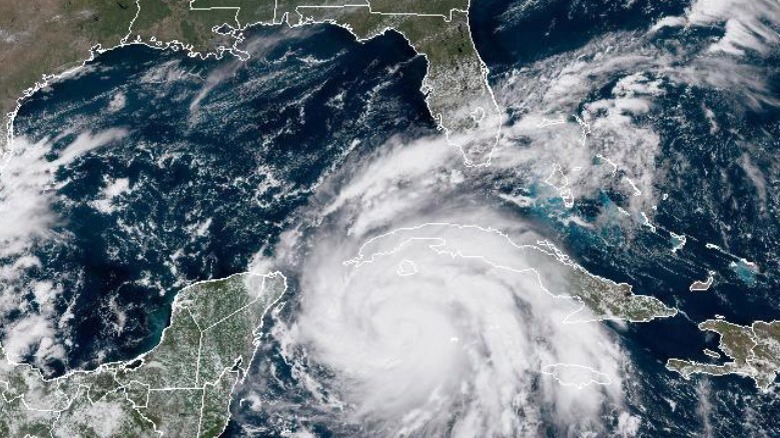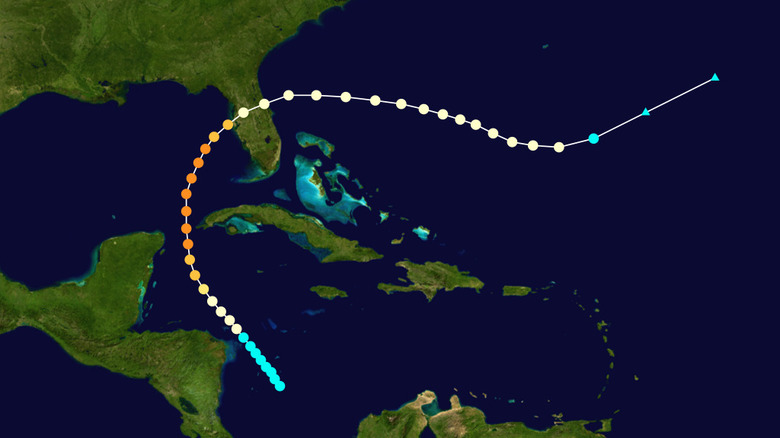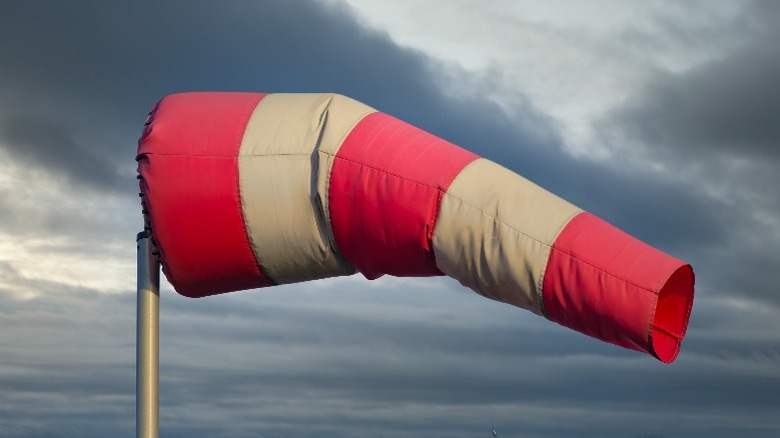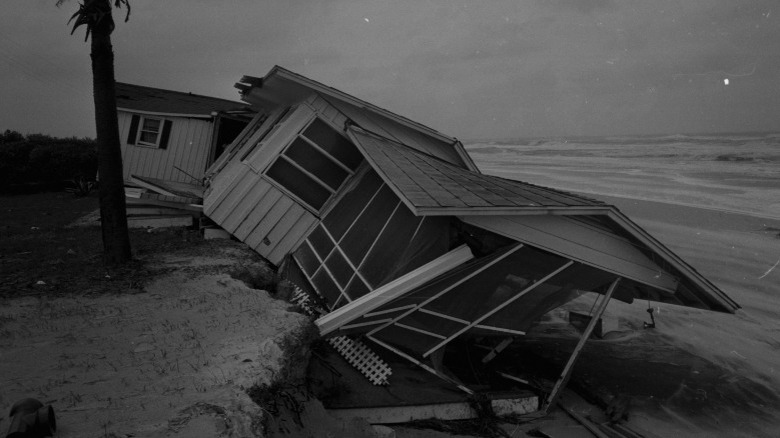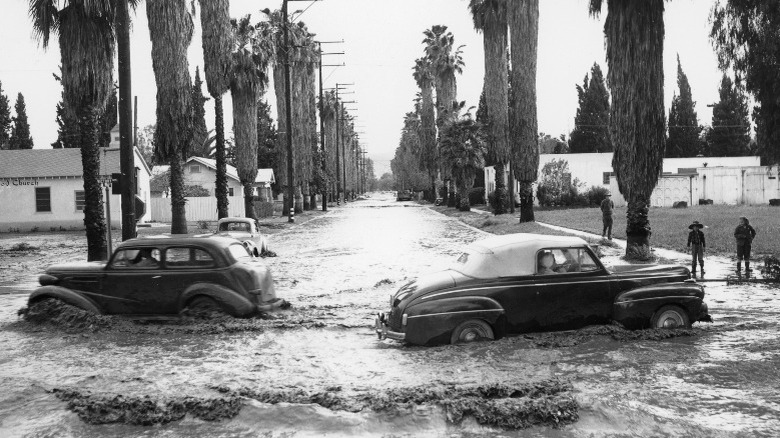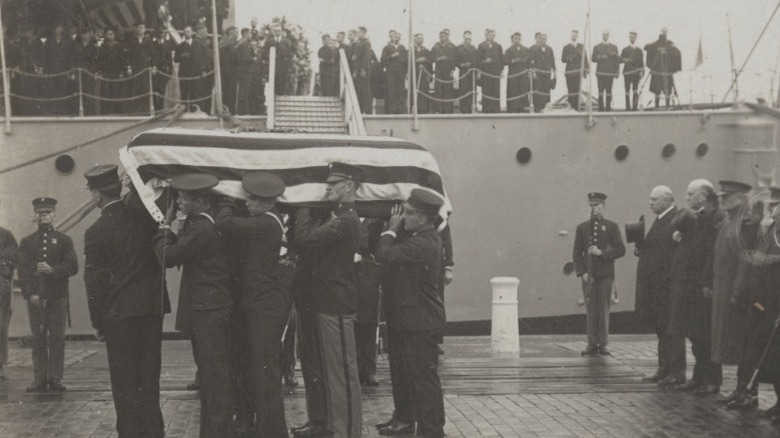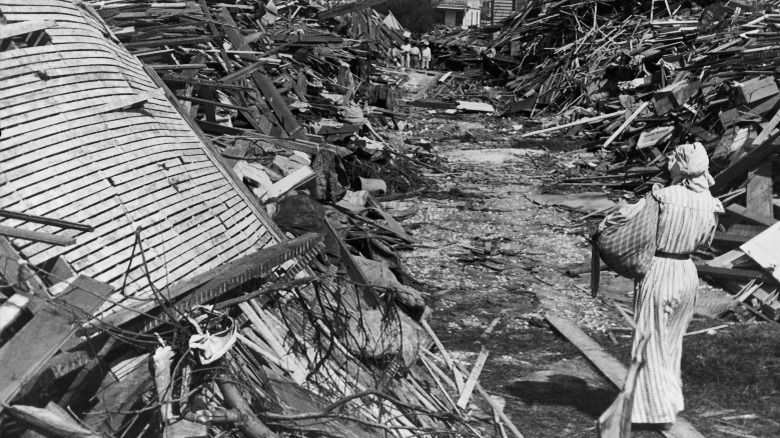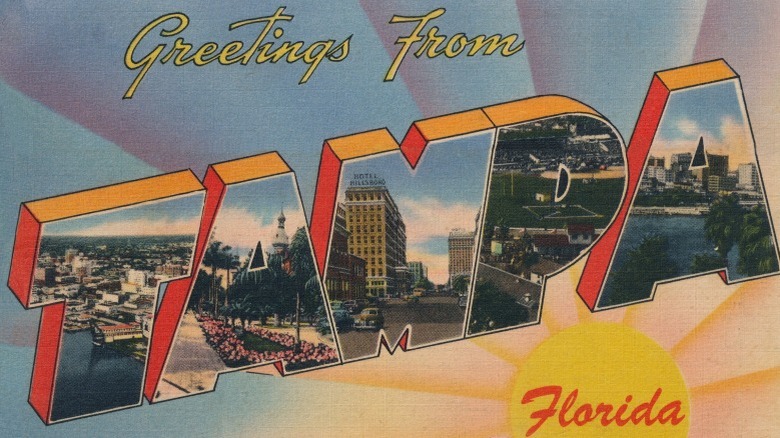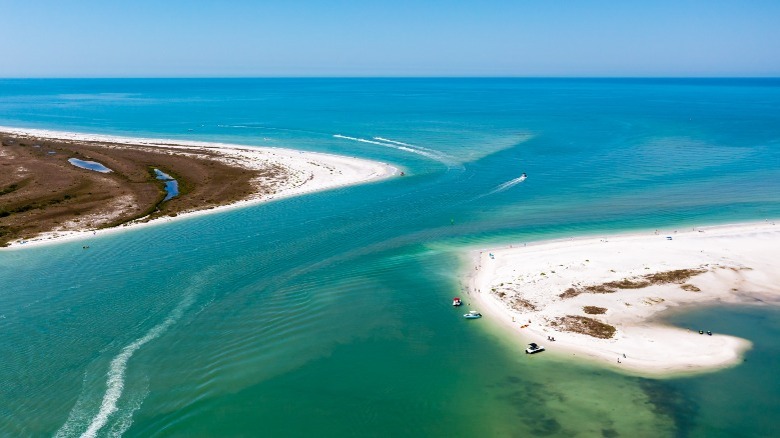The Untold Truth Of The Tampa Bay Hurricane Of 1921
Hurricanes have always been a part of life in Florida, particularly in the fall. According to the National Weather Service (NWS), the Atlantic hurricane season starts every year on June 1 and continues through November 30, peaking on September 10. Hurricanes form over warm water in the Atlantic Ocean and adjacent seas, but, by October, the oceans have cooled. This means that most late-season storms originate in the warmer Gulf of Mexico or Caribbean Sea before being carried north and then northeast by seasonal winds. This puts them on a direct path to hit Florida. Such was the case with the Tampa Bay Hurricane of 1921 – also called the Tarpon Springs Storm (per AP News) – which made landfall on Florida's west coast just over 100 years ago on October 25, 1921.
The storm lacks a characteristic given name as, per the National Hurricane Center, this convention did not start until 1950. With September 2022's Hurricane Ian making landfall in southwest Florida as well as South Carolina (per CNN), the devastation of the 1921 storm is fresh on everyone's minds. Though Ian missed Tampa Bay, a 2015 study published in Nature Climate Change notes that high-impact cyclones are expected to increase in Tampa, Florida, in the coming years. As a timely reminder of Tampa Bay's vulnerability to such storms and the unexpected chaos of hurricanes in general, here is the untold truth of the Tampa Bay Hurricane of 1921.
The 1921 hurricane missed Cuba
Like most late-season Atlantic hurricanes, the 1921 storm formed in the warm waters of the western Caribbean Sea. According to the National Oceanic and Atmospheric Association (NOAA), it was first noted as a tropical disturbance southwest of Jamaica on October 20, 1921. From there, the storm traveled northwest and gathered strength, becoming a Category 1 hurricane with 81-mile-per-hour winds on October 21. By October 23, it had reached the waters off western Cuba, but, curiously, it did not make landfall. Per The Palm Beach Post, Cuba experienced tropical storm conditions with heavy rain but was otherwise unscathed.
Slowed by the increased friction of dry surfaces and without the warm, moist air of the ocean providing constant energy, hurricanes rapidly lose strength when crossing land (per the University of Rhode Island's Hurricanes: Science and Society). At 777 miles long and 119 miles across at its widest, the island of Cuba is the largest land mass between Florida and the Caribbean Sea (per Britannica). But, as a 1921 study published in the Monthly Weather Review notes, instead of impacting Cuba, the hurricane sidled past via the Yucatán Channel and reached its maximum intensity. Per NOAA, it entered the Gulf of Mexico as a Category 4 hurricane with wind speeds of up to 140 miles per hour on October 24.
The hurricane's trajectory led to a lucky strike
Hurricanes rarely make a direct hit on Tampa Bay – though this may simply be due to luck. According to Florida chief meteorologist Jeff Berardelli (via WFLA), the latitude's east-to-west trade winds somewhat protect the region, steering storms west for most of the hurricane season. But in the fall – particularly October – cool air moves south and creates west-to-east air currents in the Gulf of Mexico. In order to impact Tampa Bay, a hurricane has to be pushed east at exactly the right moment in its trajectory.
As the National Hurricane Center observes, hurricanes have historically been far more likely to hit southwest Florida. Still, three known hurricanes have made landfall in Tampa Bay in the last 200 years: one in 1848, another in 1946, and, of course, the major storm of 1921 (per Weather Underground). According to AccuWeather, the Tampa-St. Petersburg area has an 11% chance of being impacted by a hurricane each year. As chief meteorologist Mike Clay notes in The Tampa Bay Times, "The odds are low but the consequences are high."
No evacuation orders were issued
As the hurricane approached the western coast of Florida, warnings were sent out from Key West to Apalachicola starting on October 24, 1921 (per The Palm Beach Post). According to a 2008 study published in Tampa Bay History, the storm was given a cursory mention in the October 23, 1921, issue of The Tampa Morning Tribune, and the U.S. Weather Bureau issued storm advisories via telegraph that same afternoon. Finally, just after noon on October 24, hurricane warnings went out. As a 1921 study published in the Monthly Weather Review notes, warnings continued to be sent out by telephone and wire on the morning of October 25. But these warnings came late and were far from adequate, as most never reached rural areas (per the 2008 study).
Still, it was one of the first times in history that residents received any advanced warning of an impending storm at all (per Tampa Historical). Owing to then-relatively-new radio and cable communications, word of the storm went farther and wider than usual. But in 1921, cities had yet to develop emergency plans, so no mandatory evacuation orders were ever issued to coastal Florida residents. According to ABC News, several hundred thousand people were living in the Tampa Bay area when the storm made landfall as a Category 3 hurricane in the seaside town of Tarpon Springs on October 25, 1921.
High winds caused significant damage
As the storm approached, rainfall steadily increased on the west coast of Florida. According to data from the National Oceanic and Atmospheric Association (NOAA), rain started falling in Tampa at around 4 a.m. on October 23, 1921, and it did not let up until 9:15 p.m. on October 25. Gale force wind was next. The hurricane made landfall at Tarpon Springs in the early afternoon, pummeling the coastal town with its highest wind speeds of 80 to 100 miles per hour (per a 1921 study published in the Monthly Weather Review) between 1:30 p.m. and 2:00 p.m. Elsewhere on the coast, sustained winds of around 75 miles per hour wreaked havoc (per The St. Petersburg Times).
Throughout the Tampa Bay area, trees were uprooted, shingles, chimneys, roofs, and entire houses were sent flying, branches flew through the air, windows were shattered, signs and awnings were swept away, a wooden cupola was torn from a church, citrus fruits were ripped from trees, and telephone poles and powerlines were toppled by wind and falling trees, creating additional hazards and knocking power out across the affected cities (per The St. Petersburg Times). Based on splintered trees, The Tallahassee Democrat observed that a tornado may have even touched down. As The St. Pete Catalyst notes, wood structures didn't stand a chance against such high winds – and back then, everything was built out of wood.
A record storm surge flooded coastal towns
Along with high winds came a ton of salt water. This storm surge – defined by NOAA as the sudden rise in tide due to powerful swirling winds pushing water toward the coast – is the most destructive and dangerous component of a hurricane making landfall. Per NOAA data, the 1921 hurricane caused a massive storm surge resulting in a tide 10.5 feet higher than normal – nearly double the height of the 1848 hurricane's tide, which had set the previous record.
During the surge, seawater burst over seawalls and rushed into coastal towns, demolishing bridges, docks, and piers, sinking ships, flooding homes and businesses, destroying roadways, drowning cattle (per Tampa Bay Newspapers), and tossing boats into city streets. In some cases, water flowed past second-story windows and, according to the National Weather Service Tampa Bay, city streets were submerged in several feet of water.
As it turns out, storm surges are particularly disastrous in Tampa Bay – in fact, according to a 2015 report by catastrophe modeling firm Karen Clark & Company (via Insurance Journal), Tampa is the most storm surge-prone city in the United States. As National Weather Service Tampa Bay meteorologist Austen Flannery explains, the bay's shallow depth and shape combine to create a flooding nightmare during a direct hit from a hurricane. According to Flannery, "All the water is forced up along the shoreline because it has nowhere else to go." And in 1921, that's exactly what happened.
The hurricane threatened the ship carrying the Unknown Soldier
According to NOAA data, the hurricane made its way northeast across the Florida peninsula, its eye passing just north of Tampa. By early morning on October 26, 1921, it had been reduced to a Category 1 hurricane. That evening, the storm reached Florida's east coast and entered the Atlantic Ocean with winds around 80 miles per hour. It briefly regained strength on October 27, but by October 30, it had weakened considerably and been reabsorbed by another storm. But its story doesn't end there! As The Washington Post notes, the USS Olympia set sail from France carrying the body of an unnamed American soldier on October 25 – the day the hurricane made landfall.
The body was chosen at random for a planned memorial in the U.S., loaded onto the ship, and strapped to the deck with all the rope they could spare. As it turned out, the extra support was warranted. After an already tumultuous journey, the Olympia encountered rough seas on November 1. According to the Independence Seaport Museum (via The Washington Post), the ship likely crossed paths with the remnants of the 1921 hurricane around November 3, and indeed storm conditions intensified through November 6, with 13-foot waves and 30-mile-per-hour winds pummeling the ship and injuring several sailors. Luckily, the ship and its crew survived the voyage and the Tomb of the Unknown Soldier was dedicated on November 11, 1921, to honor the 117,000 Americans killed in World War I.
The 1921 hurricane claimed at least eight lives
Surprisingly, given the lack of preparedness and advanced warning, most people survived the hurricane. Still, as Jay Barnes notes in his book "Florida's Hurricane History," at least eight people died on Florida's west coast as a result of the storm. Two people drowned in Tampa and three others died as a result of electrocution by downed powerlines. (Per a 2008 study published in Tampa Bay History, two of the three were Black children whose names were never printed.) According to the St. Petersburg Times (via "Florida's Hurricane History"), a 75-year-old man died of a heart attack while securing his home's windows and doors for the storm's impact, and an 18-year-old man was crushed by a fallen roof. An icehouse operator also drowned near Punta Gorda (per "Florida's Hurricane History").
And these are just the deaths that are accounted for. According to The St. Petersburg Times (via ABC Action News), an elderly couple living on Rocky Point – a promontory that juts into Tampa Bay – found themselves surrounded by water after the hurricane destroyed their house. Desperate, the couple climbed a palm tree and miraculously weathered the night. But, early the next morning, the 85-year-old woman lost consciousness. Her 75-year-old husband held her as long as he could, but, eventually, she fell into the flooded bay and was never found.
1920s hurricane tracking was not very accurate
In the 1920s, most hurricane tracking was accomplished using direct observation of the sea's conditions, changes in the weather, and reports from areas already impacted by the storm's progress (per Britannica) – satellites and radar would not be used for weather monitoring for several more decades (per The National Weather Service). These primitive methods left little time for advance warning. Plus, as Tampa Bay History Center historian Brad Massey told The Tampa Bay Times, weather-measuring instruments were far less accurate in 1921, meaning data gathered on a storm's behavior was not completely trustworthy. To make matters worse, radio was the only way to communicate quickly in the 1920s, and this technology was still relatively new and not yet widely used (per The St. Pete Catalyst).
According to a 2008 study published in Tampa Bay History, hurricane information primarily came by way of a complicated telegraph relay between U.S. Weather Bureau officials, middlemen, and emergency contacts before eventually being disseminated to the public through printed media. Obviously, this system was less than time efficient and allowed for a lot of costly errors. For example, early on October 25, 1921 – right before the Category 3 hurricane made landfall – the St. Petersburg Times ran the headline: "City escapes big hurricane" (per The Tampa Bay Times). It's possible people were reading the article when the tempest hit.
Damages were extensive and expensive
As the Tampa Bay area sifted through the rubble in the hurricane's aftermath, the true extent of the damages was realized. And it wasn't pretty. According to NOAA, the damages were most severe in the towns of Tarpon Springs, Tampa, Sarasota, St. Petersburg, Punta Gorda, Marco, Caxambus, and Fort Myers with estimated damages to homes, buildings, bridges, and docks in these regions totaling more than $3,000,000 in 1921 dollars. Many ships were also lost and, per the National Weather Service Tampa Bay, the fishing town of Cortez was almost completely destroyed. Across Florida's western coast, infrastructure that took years to build was lost in minutes.
Agriculture – one of the area's biggest income sources – was also greatly impacted. The year's citrus crops of oranges and grapefruits were blown off the trees, coming out to a total loss in some groves. As the National Weather Service Tampa Bay notes, some orchards lost 90% of the year's crop. Overall, around 800,000 to 1,000,000 boxes of fruit were lost, a value of around $1,000,000 (per NOAA). Another million dollars was lost in the form of destroyed truck crops and fertilizer, and saltwater flooding also damaged soil for future crops. All and all, per Weather Underground, total damages for western Florida were estimated at around $10,000,000 – over $165,000,000 in 2022's dollars (per Currency Converter).
The catastrophe was intentionally downplayed
As Tampa Historical observes, historians have had a heck of a time sorting through the true impact of the 1921 hurricane – and that's no accident. According to a 2008 study published in Tampa Bay History, local businessmen, realtors, and political leaders (per The Tampa Bay Times) intentionally downplayed the damages of the storm to avoid alarming tourists and investors. Florida was experiencing a land boom in the 1920s – the entire state was marketed as a paradise, and Tampa was deemed "The Year Round City." As Tampa Bay History Center historian Brad Massey told The Tampa Bay Times, "Those who had influence did everything they could to protect that image."
In fact, some evidence suggests that these local stakeholders even suppressed knowledge of the storm's severity leading up to its landfall to avoid negative press for the region (per the 2008 study). In the end, they succeeded. As The Tampa Bay Times notes, the population of Tampa doubled from 1920 to 1930, developing into the thriving metropolitan area it still is today. But the looming threat of another catastrophic hurricane impacting the region has not gone away – though one reporter for the October 28, 1921, Tampa Morning Tribune (via the 2008 study) confidently declared: "There will not be another storm of such severity during the life of anyone now living."
The hurricane destroyed one of Florida's main tourist attractions
While most of the focus understandably went to lost homes and economic impacts in the 1921 hurricane's aftermath, the storm also destroyed one of Florida's irreplaceable treasures. According to The Evening Independent (via Bayart Magazine), England native Owen Albright moved to sunny Florida to run a nursery, but a major freeze destroyed his business, bringing him to St. Petersburg in 1901. There, as James Anthony Schnur notes in his book "St. Petersburg: Through Time," Albright bought a plot of land on First Street North and built a home. He soon began decorating his property's fence with shells he gathered from local beaches – a pastime he would continue until his death.
Over time, his shell fence grew to a remarkable height of 12 feet and contained hundreds of thousands of shells held in place with plaster. The structure was divided into two main pagodas – or grottos – and, per Karl Hiram Grismer in his book "The Story of St. Petersburg," it served as one of the city's main tourist attractions for 20 years. According to The Evening Independent (via Bayart Magazine), Albright's shell fence brought a lot of interest to St. Petersburg and was even printed on postcards that traveled far and wide. Albright died at age 90 in 1920 – just one year before the hurricane would completely destroy his creation (per "St. Petersburg: Through Time").
Florida's coast was permanently altered
The 1921 hurricane hit Florida with such force that some of its coastal topography – particularly that of its barrier islands – was permanently altered. As The Anna Maria Islander notes, Passage Key – a 60-acre island that was designated as a wildlife sanctuary by President Theodore Roosevelt in 1905 – was all but annihilated by the hurricane. Its freshwater lake and most of its vegetation were washed away in the storm, and it has been declining ever since. An island once filled with 102 species of birds including laughing gulls, royal terns, and brown pelicans is now a barren sandbar that spends most of the year submerged.
In addition to its destruction, the hurricane also created new terrain. According to the National Weather Service Tampa Bay, what used to be a single large island called Hog Island was split into two new smaller islands: Honeymoon Island and Caladesi Island. The two islands are now separated by a wide channel – Hurricane Pass – that was carved out by the storm over the course of a few hours on the afternoon of October 25, 1921. Hurricane Pass (pictured) is now the area's main entrance and exit point. Meanwhile, the waterway's previous main channel, Big Pass, vanished as it was slowly filled in with sand. With hurricanes, it's always out with the old, in with the new – and things can change drastically in an instant.

